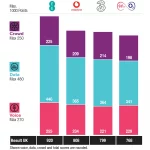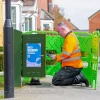BT Results See Full Fibre Grow by Record of 763,000 UK Premises

The BT Group has published their Q1 2022/23 results to June 2022, which saw the coverage of Openreach’s gigabit-capable Fibre-to-the-Premises (FTTP) broadband ISP network reach 7.957 million premises (up by a record of 763K in the quarter vs 752K last quarter). Meanwhile, EE’s 5G network now reaches 55% of the UK population.
So far as UK communication providers go, the BT Group rarely ever has a truly quiet quarter, and this one was no exception. The biggest headline grabber has of course been their pay dispute with c. 38,000 unionised (CWU) workers, which is due to result in a major 2-day national strike – starting tomorrow (here).
Elsewhere, fears of a possible takeover attempt by key BT investor Altice UK has prompted the Government to launch a national security assessment (here), while Openreach added lots of new locations to their FTTP rollout plan (here and here) and also gave their FTTP-on-Demand (FTTPoD / FoD) product a stay of execution (here). Finally, BT moved to remove email and online cloud storage features from new broadband packages (here).
Advertisement
Otherwise, the operator’s main event continues to be their £15bn investment to deploy – via Openreach – a new full fibre broadband network to reach 25 million UK premises by December 2026. Some 6.2 million of those will be in rural or semi-rural areas.
Financial Highlights – BT’s Quarterly Change
* BT Group revenue = £5,133m (down from £5,168m)
* BT Group profit after tax = £422m (up from £388m)
* BT Group total net debt = £18,891m (increased from £18,009m)
Sadly, BT’s (EE) consumer division doesn’t publish full customer figures for their own retail broadband ISP, except on their ultrafast services. The consumer ISP thus reported that they had 1.283 million FTTP customers (up from 1.165m last quarter) and EE’s “5G Ready” base now stands at 7,737 million (up from 7.228m).
Meanwhile, some 79.3% of BT’s fixed consumer base take a “superfast broadband” product (down from 80.2% last quarter), which drops to 11.5% (up from 10.1%) for their “ultrafast broadband” (100Mbps+) products – including both G.fast and FTTP. We also noted that 21.8% of BT’s customers are now taking both mobile and broadband (converged) – up slightly from 21.7%.
Openreach’s Network
The table below offers a breakdown of fixed line network coverage and take-up by technology on Openreach’s UK network, which covers the totals for all ISPs that take their products combined (e.g. BT, Sky Broadband, TalkTalk, Zen Internet, Vodafone etc.).
Advertisement

The rollout of full fibre (FTTP) lines continues to grow, with a new record of +763,000 premises being added in a single quarter (up from +752K last quarter). As for take-up, some 2.07 million FTTP broadband connections have been made on Openreach’s network (up from 1.771m), which equates to a take-up of 26.05% (up from 24.62% last quarter).
The rapid rollout of a new network almost always tends to suppress the take-up figures, thus Openreach is doing extremely well to buck that trend with their FTTP build. All of this is despite the increasingly significant amount of rising competition from a mass of alternative full fibre networks.
Philip Jansen, CEO of BT Group, said:
“BT Group has made a good start to the year; we’re accelerating our network investments and performing well operationally. Despite ongoing challenges in our enterprise businesses, we returned to revenue and EBITDA growth in the quarter.
We continued to grow the number of BT and EE customers connected to our next generation networks. We’re building our full fibre broadband network faster than ever and we’re seeing record customer connections – both ahead of our own expectations. Openreach’s full fibre network now reaches over 8 million homes and businesses across the UK and we anticipate increasing our annual build from 2.6 million premises last year to around 3.5 million this year. EE’s 5G network covers more than 55% of the country’s population. We’re achieving continued high customer satisfaction scores thanks to our much improved customer service and the value for money that our products and services represent.
The modernisation of BT Group remains on track. We are delivering and notwithstanding the current economic uncertainty we remain confident in our outlook for this financial year.”
Generally, there’s not a lot more to say this time around, except that the operator has also finalised its FTTP co-provisioning agreement with Sky (Sky Broadband). In other words, Sky’s engineers will now be able to “complete the majority of their FTTP in-premises provisioning activities” (this is usually the job of Openreach’s team) and that might save Sky some money, while taking some pressure off Openreach.
Advertisement
Mark is a professional technology writer, IT consultant and computer engineer from Dorset (England), he also founded ISPreview in 1999 and enjoys analysing the latest telecoms and broadband developments. Find me on X (Twitter), Mastodon, Facebook, BlueSky, Threads.net and Linkedin.
« Global Shortage of Fibre Optic Cables Hits UK Broadband Firms UPDATE
Virgin Media O2 Add 114,000 New Premises to UK FTTP Coverage »























































I would like to see how many customers Virgin Media lost as a result of this since VM are too busy fleecing as much as they can out of existing/out of contract customers with their ‘now’ obsolete and inferior HFC product which is susceptible to noise and with a congested and intermittent network where as an FTTP option which is far more superior, stable and cheaper — if one can get it of course which everyone should once it’s available to them.
I think the demographics of a typical BT customer are amongst the upper age bands of us.
People like my parents / grandparents won’t ‘risk’ switching supplier away from BT as they don’t seem to place trust with the others even though they sell a much better product at much cheaper prices. AltNets are technically superior to BT broadband.
All BT has to trade on here is their brand reputation from decades over the Strowger days.
@Jerry
“AltNets are technically superior to BT broadband”
That is demonstrably incorrect – some are deploying more current FTTP tech (ie XGS-PON – I don’t believe that Openreach is yet?), but others are broadly equivalent to Openreach and some have less resilience, are using fixed wireless etc.
In terms of customer demographics, you’re right that consumers using the BT brand tend to be older but that isn’t the case for EE customers (I can’t remember the demographics of the value brand, Plusnet). And the age profile will have changed recently as the BT brand was an early adopter of FTTP, compared both to the other BT Group brands and to the other large ISPs.
You are right, my next door neighbour did not want to switch from BT, because they trusted BT.
it took their daughter to eventually get them to change to Sky broadband, they have Sky Tv and having sky broadband as well was the best way, so their daughter said.
just a shame that sky got the address wrong and my ISP sent me a sorry you are leaving email. 🙂 Sorted it in the end, but then it took another couple of weeks for my neighbour broadband to change over.
What annoyed me with sky was that they did not tell my next door neighbour they had to plug their phone into the router. Someone was supposed to go and sort out the extensions, I had to do it in the end.